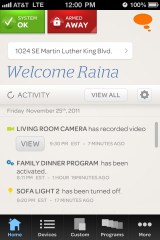Some day, you’ll never have to worry about whether you left the lights on, the garage door open or the curling iron plugged in, because you’ll be able to control it all remotely by phone or tablet. AT&T is offering a taste of that future right now–as long as you buy a home security package to go with it.
On Friday, the company is launching its Digital Life service, which combines home security with optional home automation. The service launches in 15 markets: Atlanta, Austin, Boulder, Chicago, Dallas, Denver, Houston, Los Angeles, Miami, Philadelphia, San Francisco, Seattle, St. Louis, select areas of New York and New Jersey and Riverside, Calif. AT&T hopes to offer the service in 50 markets total by the end of the year.
AT&T already has plenty of competition–ADT and Verizon being the most noteworthy alternatives, along with do-it-yourself automation setups–but a few things about AT&T’s approach stand out.
First, the company is putting all the pricing details right on its website, which sounds like a no-brainer until you realize ADT makes you call a 1-800 number to get that information. And unlike Verizon, which requires users to install their own hardware, AT&T does the installation itself, including any necessary electrical work.
Also, AT&T has some slick-looking mobile apps that allow you to control several things at once. For example, you can have an event to turn the heat up and switch the hallway lights on when you wake up, or shut off all your outlets and turn the heat down while you’re on vacation. You can also control things room-by-room, or set up custom groups for multiple outlets and appliances around the house.
As for the security itself, Digital Life uses AT&T’s network to stay connected. Hold your laughter; it also uses your existing wired Internet connection as a fallback. In case of a power outage, the service comes with a 24-hour battery backup.
I’ve been interested in home automation for a while, but not enough to try a do-it-yourself setup. Still, there are a couple things that would keep me away from AT&T’s service–aside from the fact that it’s not available in my area:
- AT&T charges $30 for security alone, but the only way to get home automation is to buy a $40 per month “Smart Security” package, which includes a choice of sensors such as carbon monoxide, motion, smoke and broken glass. There’s no way to get home automation by itself.
- The additional automation costs can add up: $5 per month for appliance controls, $5 per month for door controls, $10 per month for water controls and $10 per month for cameras. On top of that, installation can range from about $150 to $200.

Despite my hesitations, AT&T may have the right strategy. A recent survey by the Consumer Electronics Association noted that only 1.7 million households have home automation now, but 62 percent of respondents would be interested in the service as part of a security package. And as AT&T Senior Vice President Kevin Petersen said in an interview, a lot of people are already paying for security.
“It’s under-penetrated, it’s fragmented, we feel the experience is not ideal, so our model … is to lead with security,” Petersen said.
AT&T hasn’t ruled out offering a standalone home automation package, but won’t offer that option at launch. As for bringing the price down, AT&T may introduce some bundles in the future for existing wireless or home Internet subscribers. Petersen also expects the cost of home automation to fall on its own over time.
“I think we’re at or near the top of the cost curve, both in terms of the device as well as the installation of these things,” he said. “It’s one of those things where you need to start putting the scale behind it to drive the cost down,” he said.
Now that most Americans own a smartphone, and a more than a quarter own a tablet, the idea of controlling our homes seems ready to take off, but it’s not going to happen until the automation part becomes easier to set up and use. Slowly, we’re getting there.

